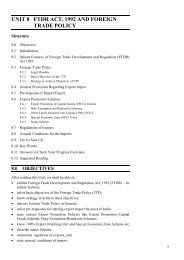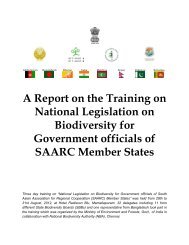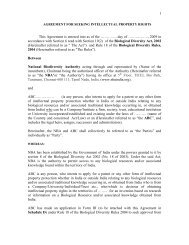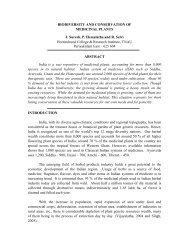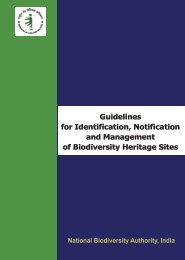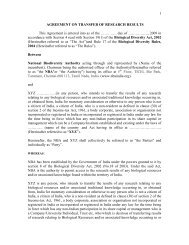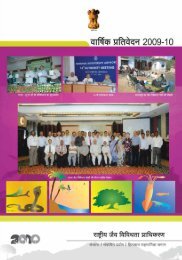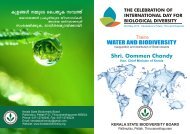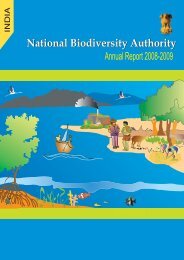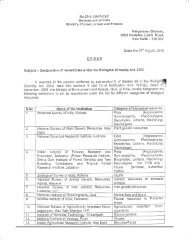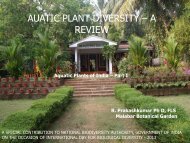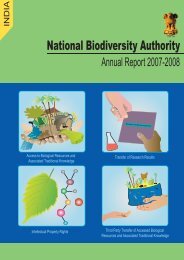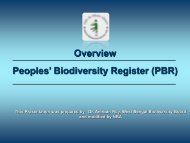BCIL BOOK.pmd - National Biodiversity Authority
BCIL BOOK.pmd - National Biodiversity Authority
BCIL BOOK.pmd - National Biodiversity Authority
Create successful ePaper yourself
Turn your PDF publications into a flip-book with our unique Google optimized e-Paper software.
NATIONAL BIODIVERSITY ACTION PLAN<br />
<br />
<br />
<br />
<br />
<br />
<br />
<br />
<br />
<br />
<br />
32<br />
Strengthen capacities and implement measures<br />
for captive breeding and release into the wild of<br />
identified endangered species.<br />
Reintroduction and establishment of viable<br />
populations of threatened plant species.<br />
Control poaching and illegal trade in wild animals<br />
and plant species.<br />
Periodically revisit the norms, criteria and needs<br />
of data for placing particular species in different<br />
schedules of the Wildlife (Protection) Act.<br />
Promote ecological and socially sensitive tourism<br />
and pilgrimage activities with emphasis on<br />
regulated and low impact tourism on a sustainable<br />
basis through adoption of best practice norms.<br />
Formulate and implement partnerships for<br />
enhancement of wildlife habitat in conservation<br />
reserves and community reserves, on the lines<br />
of multistakeholder partnerships for<br />
afforestation, to derive both environmental and<br />
eco-tourism benefits.<br />
Promote conservation of biodiversity outside the<br />
PA network, on private property, on common<br />
lands, water bodies and urban areas.<br />
Formulate and implement programmes for<br />
conservation of endangered species outside PAs.<br />
Ensure conservation of ecologically sensitive<br />
areas, which are prone to high risk of loss of<br />
biodiversity due to natural or anthropogenic<br />
factors.<br />
Ensure that survey and bioprospecting of native<br />
economically important biological resources is<br />
undertaken on a priority basis.<br />
Integrate conservation and wise use of wetlands<br />
and river basins involving all stakeholders, in<br />
particular local communities, to ensure maintenance<br />
of hydrological regimes and conservation of<br />
biodiversity.<br />
Consider particular unique wetlands as entities of<br />
incomparable values, in developing strategies for<br />
their protection and formulate conservation and<br />
prudent use strategies for the identified wetlands<br />
with participation of local communities and other<br />
stakeholders (Box 7).<br />
On-farm conservation<br />
Identify hotspots of agro-biodiversity under<br />
different agro-ecozones and cropping systems and<br />
promote on-farm conservation.<br />
Provide economically feasible and socially<br />
acceptable incentives such as value addition and<br />
direct market access in the face of replacement by<br />
other economically remunerative cultivars.<br />
<br />
Develop appropriate models for on-farm<br />
conservation of livestock herds maintained by<br />
different institutions and local communities.<br />
Develop mutually supportive linkages between in<br />
situ, on-farm and ex situ conservation programmes.<br />
Ex situ conservation<br />
<br />
Box 7: Regulatory Framework for Wetlands<br />
Recognizing the value of wetlands and taking cognizance<br />
of the fact that there does not yet exist a formal system of<br />
wetland regulation, the <strong>National</strong> Environment Policy seeks<br />
to set up a legally enforceable regulatory mechanism for identified<br />
valuable wetlands to prevent their degradation and enhance<br />
their conservation. It also undertakes to develop an<br />
inventory of such wetlands. In pursuance of the policy resolution<br />
a draft regulatory framework for the wetlands has been<br />
formulated for wider consultation.<br />
Source : Conservation of Wetlands in India: A Profile Ministry of<br />
Environment and Forests, Government of India 2007<br />
Promote ex situ conservation of rare, endangered,<br />
endemic and insufficiently known floristic and<br />
faunal components of natural habitats, through<br />
appropriate institutionalization and human resource<br />
capacity building. For example, pay immediate<br />
attention to conservation and multiplication of rare,



